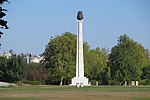Ušće, Belgrade

Ušće (Serbian Cyrillic: Ушће; pronounced [ûːʃt͡ɕe]) is an urban neighborhood of Belgrade, the capital of Serbia. It is located in Belgrade's municipality of Novi Beograd. Ušće is located on the mouth of the Sava river into the Danube, thus the name (ušće is Serbian for confluence). It occupies Novi Beograd's Blocks 10, 13, 14, 15 and 16 on the Sava's left and the Danube's right bank, covering a tip of land that overlooks the islands of Little War Island and Great War Island to the north and the old core of Belgrade, the fortress of Kalemegdan to the west. Ušće borders the neighborhoods of Staro Sajmište and Savograd on the south. As a compact grassy and forested area it stretches along the bank of the Danube into the Block 10, to the Zemun municipality and the Hotel Jugoslavija and the ENJUB shopping mall. Spanning over 0.52 square kilometres (0.20 sq mi), Park Ušće is the largest official park area in Belgrade.
Excerpt from the Wikipedia article Ušće, Belgrade (License: CC BY-SA 3.0, Authors, Images).Ušće, Belgrade
Peace Avenue, Belgrade New Belgrade (New Belgrade Urban Municipality)
Geographical coordinates (GPS) Address Nearby Places Show on map
Geographical coordinates (GPS)
| Latitude | Longitude |
|---|---|
| N 44.819039 ° | E 20.436931 ° |
Address
Алеја мира
Peace Avenue
11000 Belgrade, New Belgrade (New Belgrade Urban Municipality)
Central Serbia, Serbia
Open on Google Maps









